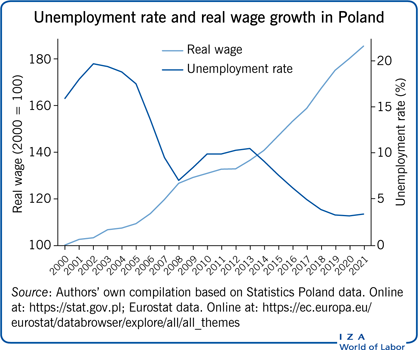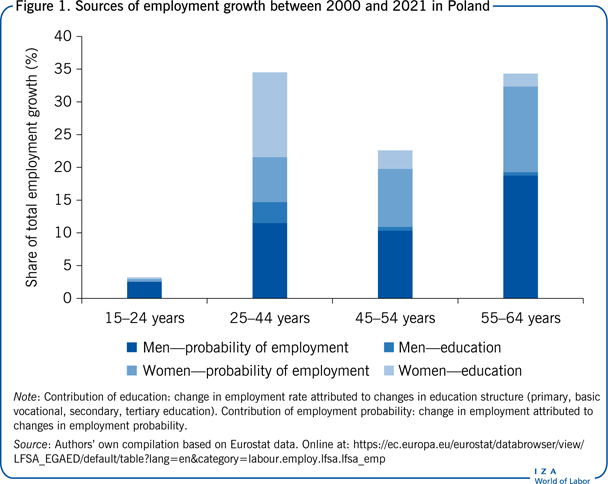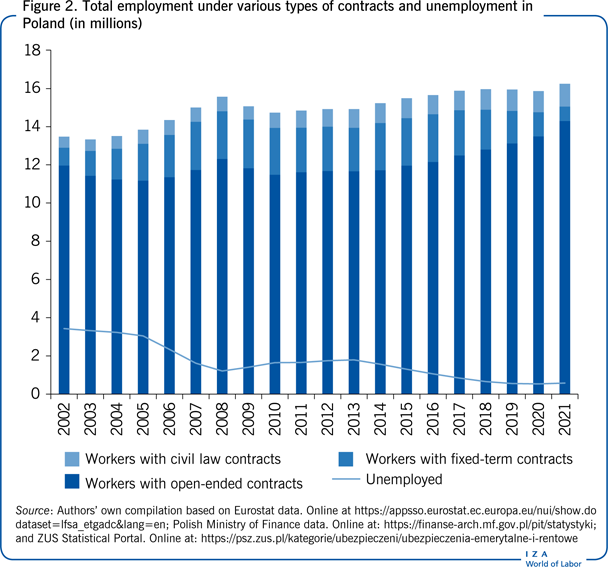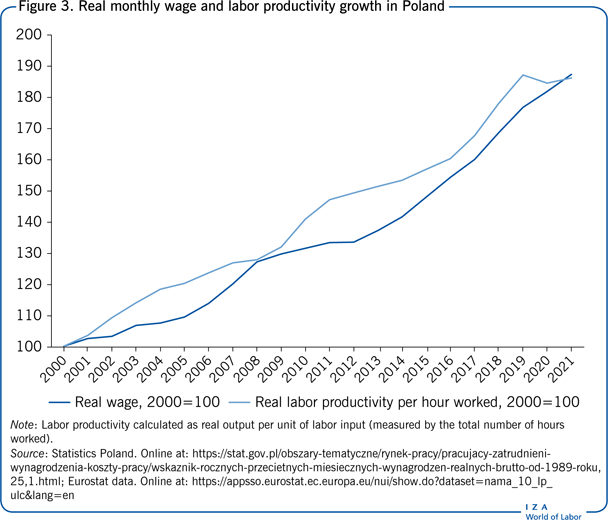Elevator pitch
In the early 2000s, Poland's unemployment rate reached 20%. That is now a distant memory, as employment has increased noticeably and the unemployment rate had dropped to 3.4% in 2021. The labor force participation of older workers increased following reforms aimed at prolonging careers. However, participation remains low compared to most developed countries and the reversal of the statutory retirement age in 2017 leaves Poland vulnerable to the effects of population aging. Rising immigration has eased the resulting labor shortages, but women, people with disabilities, and agricultural workers remain underemployed. During the Covid-19 pandemic the slowdown in economic growth and increase in unemployment were small.

Key findings
Pros
The employment rate for people aged 15–64 increased significantly between 2000 and 2021, while the unemployment rate declined noticeably over the same period; long-term unemployment dropped from 10% in 2003 to 0.6% in 2021.
In 2021, the labor force participation of older workers reached its highest level since the 1990s.
Real wages increased by 87% between 2000 and 2021.
Real wage growth was the highest at the bottom of the wage distribution, and earnings inequality has decreased in the last two decades.
In 2012–2016, Poland had the highest share of temporary employment in the EU, but it has decreased since then.
Cons
Labor force participation of older workers remains low compared to most developed countries; the reduction of the retirement age in 2017 exacerbates the decline in labor supply resulting from population aging.
The adjusted gender pay gap remains high.
The total compensation of employees as a share of GDP is among the lowest in the EU.
The share of agricultural employment remains high.
Lack of a migration strategy hampers the impact of immigration on labor shortages.
Author's main message
The Polish labor market appears to be in very good shape: the employment rate is historically high, and the unemployment rate has dropped to a record low level. Since the mid-2000s, wage growth has accelerated, and wage inequality has declined, supported by the rising minimum wage. However, labor force participation at older ages remains low, and the rapidly aging population will further reduce labor supply. Since 2014, large immigration inflows have reduced labor shortages, but mainly in low-skilled jobs. The lack of migration and integration policy hinders matching migrant workers with jobs.
Motivation
In the early 2000s, Poland had one of the highest unemployment rates among current EU member states. Robust employment growth starting in 2004 and the country's resilience in the Great Recession changed the labor market outlook dramatically. In 2021, the employment rate was at a record high, while the unemployment rate was only 3.4%. However, there are several cracks in this positive picture. Labor's share of national income is one of the lowest in the EU. Job quality is also an issue, mainly due to the high share of temporary contracts. Relatively low labor force participation among women and older workers contributes to labor shortages, which are aggravated by a shrinking productive-age workforce. The retirement reforms introduced between 2009 and 2013 seem to have been successful, as participation and employment among older workers increased in their aftermath. However, the retirement age was lowered in 2017. Recently, labor shortages have been eased mainly by immigration.
Discussion of pros and cons
Unemployment and employment developments
The labor market situation in Poland improved substantially between the early 2000s and the 2020s. After the unemployment rate among people aged 15–64 reached a record high of 20.2% in 2002, it declined rapidly to a historically low level of 3.4% in 2021. The Great Recession had a moderate impact on the Polish economy, which experienced only a slowdown in economic growth in 2009–2010. The unemployment rate rose to 10.6% in 2013, about half of the previous peak recorded during the 2001–2002 downturn. The slowdown in growth and unemployment increase during the Covid-19 pandemic were also small.
In absolute terms, unemployment in Poland declined from its highest point of 3.4 million people in 2002 to 0.6 million in 2021. The incidence of long-term unemployment (12 months and more) has also shrunk. From 2001 to 2007, the long-term unemployment rate averaged 9.2%, and between 2002 and 2005 it exceeded 10%. Since 2018 it has remained below 1%.
The reduction in unemployment was largely driven by employment growth. Since 2004, after a period of severe stagnation in the labor market, employment in Poland has been growing vibrantly. The employment rate increased from 51.7% in 2004 to 59.2% in 2008, remained flat during the Great Recession, and rose to 70.3% in 2021.
Three features of recent employment growth in Poland stand out. First, the rising tertiary education attainment of labor market entrants translated into a noticeable educational upgrading of the workforce—the employment share of college graduates rose from 13.9% in 2000 to 37.2% in 2021. Second, the employment rate of older workers increased, especially after 2006. Between 2000 and 2021, the employment rate of the population aged 15–64 increased by 15.1 percentage points. Of this increase, 3.4 percentage points (22%) can be attributed to changes in the educational structure of the workforce, especially among prime-aged women. In comparison, 11 percentage points (72%) can be attributed to the increase in the probability of employment, especially among people aged 45–64, and men aged 25–44 (Figure 1).

Third, temporary employment skyrocketed. It includes work under fixed-term contracts, the so-called “civil law contracts,” and temporary agency work. Between 2002 and 2016, the number of workers with temporary contracts more than doubled (Figure 2). Since then, the number of workers with civil law contracts has stagnated, and the number of workers with fixed-term contracts has decreased. Of the 2.2 million total net jobs created between 2002 and 2016, 2.0 million were temporary jobs. In 2012, Poland surpassed Spain to have the highest share of temporary jobs in the EU (over 20% of total employment in 2006–2017), but it dropped back in 2017. Between 2002 and 2008, temporary employment increased by 1.7 million workers, primarily because of inflows of previously jobless people. Between 2008 and 2016, the total growth in temporary jobs slowed considerably, with an increase of an additional 250,000 temporary workers. In this latter period, temporary employment grew mainly due to increasing worker spells in temporary jobs. Worker flows from temporary to permanent jobs subsequently declined, aggravating labor market segmentation. People aged 20–39, and those with primary, basic vocational, and secondary educational levels have been overrepresented among temporary workers [1]. Most temporary jobs were taken involuntarily because workers could not obtain permanent contracts. The high incidence of temporary contracts has thus replaced unemployment as the main labor market concern.

In contrast to countries like Spain, the rise in temporary employment in Poland was not preceded by any deregulation of the rules pertaining to temporary contracts, nor by any increase in the regulation of permanent contracts. However, there was a general movement toward less strict regulations. It was fuelled by the growth of loosely regulated temporary agency work and outsourcing that often involved precarious contracts.
A raft of changes increasing the regulation of temporary contracts was introduced in 2016. A maximum total duration of fixed-term contracts was set, stricter limits on their renewal were introduced, and dismissal notice periods were equalized with those on open-ended employment contracts. Moreover, minimum social security contributions on civil law contracts were increased, and in 2017 an hourly minimum wage covering these contracts was enacted.
In the aftermath of these reforms, temporary employment declined by 0.9 million workers between 2016 and 2021. Strong labor demand and growing worker shortages also contributed to this shift. In 2021, temporary employment accounted for 12% of total employment in Poland, 11 percentage points lower than in 2014 when it peaked. Yet, in 2021 Poland still had the second-highest share of temporary workers in the EU.
The impact of the Covid-19 pandemic on the Polish labor market was mild. In 2020, employment declined by only 80,000 people compared to 2019 (15 to 64-year-olds). Employment reductions in sectors affected by the lockdowns, especially services and construction, and to a lesser extent manufacturing, were cushioned by an increase in the number of people working in agriculture. In 2020, the number of agricultural workers went up by 80,500 people (5.5%), reversing a long-term decline in farming employment. Agriculture also employed some labor market entrants as 46% of its new workers were inactive in 2019. This sudden increase in agricultural employment translated into a 10% decline in value-added per worker in the sector. This suggests that agriculture acted as a buffer, potentially allowing people to avoid the stigma of unemployment.
Labor force participation developments
Labor force participation in Poland has been relatively low compared to other EU countries but has grown over the past 20 years. The participation rate among those aged 15–64 ranged from 63% (2006–2007) to over 70% (2020–2021). Participation of older workers and prime-aged women has been a particular concern, but it has also risen over time, especially among older workers. Between 2001 and 2006, the participation rates of people aged 55–64 averaged 30% (only 21% among women) and were among the lowest in Europe. In 2014–2020, they increased to an average of 48%, and further to over 53% in 2021 (69% among men, 44% among women), which, though significantly higher, still ranks low compared to most developed countries.
Two major reforms aimed at extending working lifespans have been introduced in Poland since the 2000s [2]. The first reform, implemented in 2009, eliminated the long-standing early retirement system that had allowed workers in a wide range of professions to retire before reaching the statutory retirement age (age 60 for women, 65 for men). In most cases, a worker could take early retirement up to five years before reaching the statutory retirement age, so women at age 55 and men at 60. In some professions, however, workers could retire at even earlier ages. The 2009 reform replaced the early retirement system with the so-called “bridging pension system,” which covered a much narrower range of professions with much more restrictive conditions for accessing early retirement. The 2009 reform mainly affected men born after 1948 and women born after 1953.
The second crucial reform was implemented in 2013. The statutory retirement age was gradually increased by four months per year, starting with men born in 1948 and women born in 1953. The target age of 67 was supposed to be reached in 2020 for men and in 2040 for women. However, this reform was repealed by a law that reduced the retirement age back to 60 for women and 65 for men, which came into effect on October 1, 2017.
In the wake of the 2009 and 2013 reforms, the labor force participation rates of the affected cohorts increased. Although the overall improvement in labor market conditions has likely also contributed to the rising participation of older workers, there is evidence that cohorts affected by the reforms recorded a stronger increase in participation than those not affected [3]. Higher labor force participation rates translated into higher employment rates, while the unemployment rate of workers aged 55–64 remained below the total unemployment rate, and declined to 2.1% in 2021. Employment rose because older people stayed in their jobs. The retention rate—or the share of workers aged 55–59 who remained employed in the same job after the age of 60—doubled between the early 2000s and the early 2010s. The reduction of the retirement age implemented in 2017 likely limited the growth of the employment rate among older workers, and the observed growth was below the potential.
Labor force participation rates of young people also emerged as a concern in the aftermath of the Great Recession, as in most European countries. In the late 2010s, despite favorable labor market conditions, over 750,000 young people in Poland were neither in education, employment, nor training. Women stayed outside the labor market mainly due to care obligations, while claims of disability and poor health were the main reasons behind young men's inactivity.
Since the early 2000s, the labor force participation of prime-aged women in Poland has stagnated, contrasting with rising female participation across Europe. Access to childcare has been relatively low, although improving, while maternity and parental leave and financial transfers directed to parents have been expanded. The introduction of the Family 500+ program in 2016—an unconditional cash transfer of 500 PLN per month for every second and subsequent child under the age of 18 was a crucial change in family policy. Until 2019 this benefit was granted for the first child under 18 only if a family's net monthly per capita income was lower than 800 PLN (or 1,200 PLN in the case of a child with a disability). In 2019, the benefit became available for all children aged 0–18. Moreover, the Family 500+ program does not affect eligibility for other benefits or count as income for other means-tested benefits and allowances. The program aims to improve families’ living standards, but it also negatively affected female labor supply when benefits were partly conditional [4].
The change in migration balance is the third key development in labor supply in Poland. Poland has traditionally been an emigration country. After EU accession in 2004, emigration increased and reduced the labor supply in Poland by more than one million people. These economic migrants were relatively young and moved mainly to the UK, Germany, the Netherlands, Ireland, and Sweden. Emigration eased the oversupply of labor in the middle of the 2000s, but in the 2010s, it aggravated labor shortages resulting from population aging. Soon, Poland became a destination country for migrants. It started with the migration inflow from Ukraine after the outbreak of the war in Donbas in 2014. Strong economic growth and the liberal attitude of the Polish government toward economic migration from the post-Soviet countries created conditions for large immigration inflows. Between 2014 and 2020, Poland had the highest inflows of temporary labor migrants of any OECD country. According to Statistics Poland, the number of foreign born aged 18 or more in Poland grew from about 100,000 in 2011, to 750,000 in 2016, to 2.2 million in 2019. Immigration was a driving force behind increasing labor supply and growth—from 2013 to 2018, it contributed, on average, about 0.5 percentage points per annum, or 13% of total GDP growth in Poland [5]. However, Poland has failed to create institutions to help migrants to integrate and recognize their skills, while migrant networks and informal institutions have remained weak as most migrants arrived in Poland recently. Consequently, migrants have taken mostly low-skilled agriculture, construction, and retail jobs, often below their nominal education level.
Real wage developments
Real wage growth stagnated in the early 2000s, reflecting poor labor market conditions and high unemployment (Figure 3). As the labor market rebounded in 2004, wage growth accelerated to over 5% in 2007 and 2008. It slowed down in the aftermath of the Great Recession, before increasing in 2013 and again exceeding 5% in 2018. If it were not for the Covid-19 pandemic, upward wage pressure would likely intensify further, following productivity gains, a substantial decrease in unemployment, and minimum wage hikes. By 2019 cumulative real wage growth from 2000 (77%) had been lower than cumulative productivity growth (87%, measured per hour worked). The gap between productivity and wage growth narrowed following a decrease in productivity in 2020 and increases in wages. Overall, wages in Poland remain relatively low compared to productivity. Labor's share of GDP amounted to 39% in 2021, an increase of 2 percentage points since 2015 but still well below the EU27 average of 47.5%. It is also lower than in most other Central and Eastern European countries.

Earnings inequality
Earnings inequality in Poland is greater than in most EU countries, with the top 10% of employees earning four times more than the bottom 10% in 2018. Inequality is greater above the median wage (the 90/50 percentile income ratio was 2.2 in 2018) than below it (the 50/10 percentile income ratio was 1.8 in 2018). A high wage premium for higher education and labor market segmentation are key factors behind this earnings inequality [6]. Wage disparities increased in the early 2000s, but have kept declining since 2006, a trend observed in most Central and Eastern European countries [7].
Changes in the minimum wage have been an important factor affecting wage growth and wage distribution, especially since 2007. Between 2000 and 2007, the minimum wage amounted to 36% of the average wage. However, following a series of hikes started in 2007, it reached 51% of the average wage in 2020. In real terms, the minimum wage grew by 113% between 2007 and 2020. These minimum wage hikes had moderate impacts: they significantly accelerated wage growth and reduced employment growth only in less-developed regions of Poland that were in the first tercile of the regional wage distribution in 2007 [8]. They also led to rising non-compliance: in 2003–2007, on average, 3.7% of eligible full-time workers were paid less than the minimum wage; by 2011–2012, this share had risen to 5.8% [9]. While more recent estimates of non-compliance are not available, by 2018, the proportion of employees earning up to 105% of the minimum wage was 12.1%, which was one of the highest in the EU.
Gender gaps
In 2020, women earned on average 92% of men's hourly wages, a level similar to that observed in the 2000s. While the average raw pay gap between men and women is relatively low in Poland compared to the other EU countries, the adjusted pay gaps (accounting for differences in individual characteristics of men and women, such as their age, education, or experience) show large gender wage inequality [10]. In the last decade, adjusted pay gaps have not fallen below 15%, although a range of factors should have benefited women (e.g. a higher share of graduates among women, falling fertility rates, increased childcare coverage, and anti-discrimination policies). The gender pay gaps in Poland have been slightly pro-cyclical—they narrowed during economic slowdowns, and widened during booms—though were mostly stable. The gender pay gaps tend to increase with age until 30–39 years, and decline among older age groups. This age pattern may reflect the selection of older men and women into employment: low-paid women are more likely to withdraw earlier from the labor market.
Limitations and gaps
Significant gaps exist in the data on the use of civil law contracts, making it difficult to investigate this segment of the temporary jobs market and its development over time. Moreover, the unavailability of data fundamentally restricts understanding the role of immigration in Poland. Reliable data about the size of immigrant stocks and flows, and the composition of migrants and their workplaces, remain fragmented. Official statistics, including the census, fail to cover the foreign-born population.
Poland also lags behind other European countries in building an administrative data infrastructure for research. In principle, tax or social security data are not accessible for researchers. Consequently, the effects of several extensive reforms—for instance, the 2009 increase and 2016 reduction of the statutory retirement age, the introduction of new child benefits, the extension of the minimum wage to civil law contracts, and income tax reforms—remain understudied.
Summary and policy advice
The Polish labor market has experienced an impressive turnaround beginning in the early 2000s. The employment rate increased and the unemployment rate fell dramatically, although labor market segmentation emerged. Some regulatory steps have been taken to discourage the excessive use of temporary contracts, but more effort is needed on this front. In addition, Poland should reduce the tax burden on low-paid workers, which is very high compared to other EU countries. This would help to reduce the excessive use of atypical contracts, which are taxed less. It would also help to increase the labor supply of low-skilled workers and individuals willing to work part-time, especially women. Active labor market policies should do more to help those with low labor market attachment enter/return to the labor market, reaching out to inactive people. Rapid population aging requires policies to (once again) increase the participation of older workers and immigration policies tailored to labor market demands.
Acknowledgments
The authors thank the IZA World of Labor editors for many helpful suggestions on earlier drafts. The authors also thank Agata Rozszczypała for excellent research assistance. Previous work of the authors contains a larger number of background references for the material presented here and has been used intensively in all major parts of this article [1], [3]. Version 2 of the article updates the content to 2021.
Competing interests
The IZA World of Labor project is committed to the IZA Code of Conduct. The authors declare to have observed the principles outlined in the code.
© Piotr Lewandowski and Iga Magda